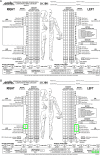Spinal cord stimulation and rehabilitation in an individual with chronic complete L1 paraplegia due to a conus medullaris injury: motor and functional outcomes at 18 months
- PMID: 33067413
- PMCID: PMC7567797
- DOI: 10.1038/s41394-020-00345-7
Spinal cord stimulation and rehabilitation in an individual with chronic complete L1 paraplegia due to a conus medullaris injury: motor and functional outcomes at 18 months
Abstract
Introduction: Epidural electrical stimulation of the conus medullaris has helped facilitate native motor recovery in individuals with complete cervicothoracic spinal cord injuries (SCI). A theorized mechanism of clinical improvement includes supporting central pattern generators intrinsic to the conus medullaris. Because spinal cord stimulators (SCS) are approved for the treatment of neuropathic pain, we were able to test this experimental therapy in a subject with complete L1 paraplegia and neuropathic genital pain due to a traumatic conus injury.
Case presentation: An otherwise healthy 48-year-old male with chronic complete L1 paraplegia with no zones of partial preservation (ZPP) and intractable neuropathic genital pain presented to our group seeking nonmedical pain relief and any possible help with functional restoration. After extensive evaluation, discussion, and consent, we proceeded with SCS implantation at the conus and an intensive outpatient physical therapy regimen consistent with the recent SCI rehabilitation literature.
Discussion: Intraoperatively, no electromyography (EMG) could be elicited with epidural conus stimulation. At 18 months after implantation, his motor ZPPs had advanced from L1 to L5 on the left and from L1 to L3 on the right. Qualitative increases in lower extremity resting state EMG amplitudes were noted, although there was no consistent evidence of voluntary EMG or rhythmic locomotive leg movements. Three validated functional and quality of life (QoL) surveys demonstrated substantial improvements. The modest motor response compared to the literature suggests likely critical differences in the anatomy of such a low injury. However, the change in ZPPs and QoL suggest potential for neuroplasticity even in this patient population.
Conflict of interest statement
The authors declare that they have no conflict of interest.
Figures





Similar articles
-
Effect of epidural stimulation of the lumbosacral spinal cord on voluntary movement, standing, and assisted stepping after motor complete paraplegia: a case study.Lancet. 2011 Jun 4;377(9781):1938-47. doi: 10.1016/S0140-6736(11)60547-3. Epub 2011 May 19. Lancet. 2011. PMID: 21601270 Free PMC article.
-
A Case of Spinal Cord Stimulation Therapy for Lower Limb Pain Due to Conus Medullaris Syndrome.Cureus. 2025 Feb 22;17(2):e79469. doi: 10.7759/cureus.79469. eCollection 2025 Feb. Cureus. 2025. PMID: 40130141 Free PMC article.
-
The Potential of Spinal Cord Stimulation in Treating Spinal Cord Injury.Curr Pain Headache Rep. 2025 Jan 27;29(1):35. doi: 10.1007/s11916-024-01311-w. Curr Pain Headache Rep. 2025. PMID: 39869234 Review.
-
Against the odds: what to expect in rehabilitation of chronic spinal cord injury with a neurologically controlled Hybrid Assistive Limb exoskeleton. A subgroup analysis of 55 patients according to age and lesion level.Neurosurg Focus. 2017 May;42(5):E15. doi: 10.3171/2017.2.FOCUS171. Neurosurg Focus. 2017. PMID: 28463613
-
Current Evidence Lacking to Guide Clinical Practice for Spinal Cord Stimulation in the Treatment of Neuropathic Pain in Spinal Cord Injury: A Review of the Literature and a Proposal for Future Study.Pain Pract. 2020 Mar;20(3):325-335. doi: 10.1111/papr.12855. Epub 2020 Feb 10. Pain Pract. 2020. PMID: 31691496
Cited by
-
Synergistic implications of combinatorial rehabilitation approaches using spinal stimulation on therapeutic outcomes in spinal cord injury.Clin Neurophysiol. 2024 Sep;165:166-179. doi: 10.1016/j.clinph.2024.06.015. Epub 2024 Jul 9. Clin Neurophysiol. 2024. PMID: 39033698 Review.
-
The 2020 Yearbook of Neurorestoratology.J Neurorestoratology. 2021 Mar 5;9(1):1-12. doi: 10.26599/JNR.2021.9040002. Epub 2022 May 10. J Neurorestoratology. 2021. PMID: 37387779 Free PMC article. Review.
-
Management of Acute Traumatic Spinal Cord Injury: A Review of the Literature.Front Surg. 2021 Dec 13;8:698736. doi: 10.3389/fsurg.2021.698736. eCollection 2021. Front Surg. 2021. PMID: 34966774 Free PMC article. Review.
-
Established and Emerging Therapies in Acute Spinal Cord Injury.Neurospine. 2022 Jun;19(2):283-296. doi: 10.14245/ns.2244176.088. Epub 2022 Jun 30. Neurospine. 2022. PMID: 35793931 Free PMC article.
-
Enabling Health Equity for persons with disability due to spinal cord injury.Spinal Cord Ser Cases. 2020 Nov 10;6(1):100. doi: 10.1038/s41394-020-00351-9. Spinal Cord Ser Cases. 2020. PMID: 33173038 Free PMC article. No abstract available.
References
-
- National Spinal Cord Injury Statistical Center. Facts and figures at a glance. Birmingham, AL: University of Alabama at Birmingham, 2020. www.msktc.org/sci/model-system-centers.%0A, https://www.nscisc.uab.edu/Public/Facts and Figures 2020.pdf.
-
- Harkema SJ, Gerasimenko Y, Hodes J, Burdick J, Angeli C, Chen Y, et al. Effect of epidural stimulation of the lumbosacral spinal cord on voluntary movement, standing, and assisted stepping after motor complete paraplegia: a case study. Lancet. 2011;377:1938–47. doi: 10.1016/S0140-6736(11)60547-3. - DOI - PMC - PubMed
Publication types
MeSH terms
Grants and funding
LinkOut - more resources
Full Text Sources
Medical

